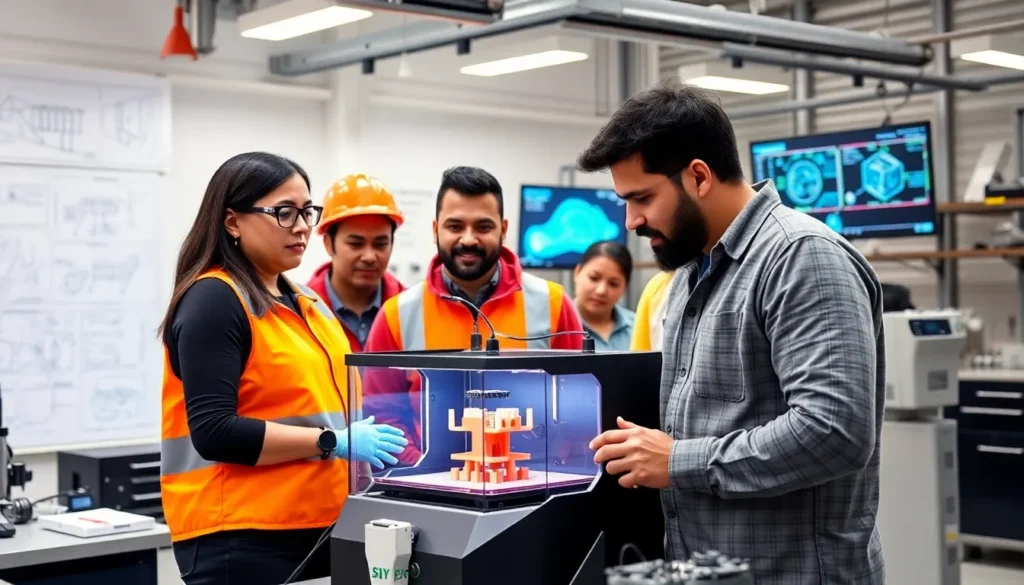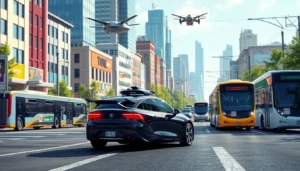Table of Contents
ToggleIn a world where technology evolves faster than a cat meme goes viral, engineering stands at the forefront of this whirlwind. Emerging technologies are revolutionizing how engineers tackle problems, turning once-impossible dreams into reality. From artificial intelligence to 3D printing, these innovations are like the Swiss Army knives of the engineering realm—versatile, powerful, and occasionally a little confusing.
Overview of Emerging Technologies in Engineering
Emerging technologies are reshaping engineering landscapes globally. Engineers now leverage artificial intelligence to enhance design processes and optimize resource management. Augmented reality transforms complex assembly tasks, allowing workers to visualize instructions in real-time environments.
The Internet of Things connects devices and systems, facilitating data exchange and real-time monitoring. Data analytics play a critical role in making informed decisions based on large sets of information. Blockchain technology offers secure methods for tracking materials and ensuring supply chain integrity.
Sustainable engineering increasingly prioritizes eco-friendly materials and practices. Innovations in renewable energy technologies promote efficiency and reduce dependence on fossil fuels. Robotics improves precision in manufacturing while minimizing human error.
Each of these technologies contributes to a streamlined workflow and promotes collaboration among engineering teams. Additionally, the integration of these advancements can lead to cost savings over time.
As technology continues to evolve, practicing engineers must adapt and embrace these tools. Increased automation allows engineers to focus on higher-level problem-solving rather than repetitive tasks. Ultimately, these emerging technologies drive productivity and enhance engineering capabilities.
Key Categories of Emerging Technologies

Emerging technologies in engineering play a crucial role in enhancing processes and efficiency. Here are some key categories reshaping the landscape.
Artificial Intelligence and Machine Learning
Artificial intelligence revolutionizes engineering by streamlining design processes. Engineers utilize machine learning to analyze vast datasets, enabling informed decision-making. Predictive analytics supports everything from maintenance schedules to product development. These technologies also optimize resource management through accurate forecasting, reducing waste. Innovations in AI empower engineers to address complex problems with more precision, enhancing overall productivity.
Internet of Things (IoT)
The Internet of Things transforms data collection in engineering. Sensors embedded in machinery provide real-time monitoring of equipment performance. Engineers access insights that lead to immediate adjustments, improving operational efficiency. Predictive maintenance minimizes downtime, and data analytics inform strategic planning. IoT fosters enhanced collaboration among teams by facilitating seamless communication and data sharing, driving continuous improvement in engineering practices.
Blockchain Technology
Blockchain technology introduces secure tracking for materials within supply chains. Engineers benefit from enhanced transparency, enabling more reliable project management. This technology ensures data integrity, making it easier to verify the authenticity of materials. Smart contracts automate transactions, reducing the risk of errors and disputes. Adoption of blockchain improves collaboration, as all stakeholders gain access to a shared database, streamlining processes within engineering projects.
Impact on Engineering Practices
Emerging technologies are reshaping traditional engineering practices across various sectors.
Enhanced Efficiency and Productivity
Artificial intelligence and machine learning streamline design and optimize workflows. Engineers harness these advancements to analyze large datasets and uncover hidden patterns. Predictive analytics supports proactive maintenance scheduling, significantly reducing downtime. Automation replaces repetitive tasks, allowing teams to focus on complex problem-solving. 3D printing accelerates prototyping processes, enabling rapid iteration and innovation. Collaboration tools enhance communication among engineering teams, driving projects forward more efficiently. Overall, these technologies lead to measurable improvements in project timelines and resource management.
Increased Safety Measures
Innovative technologies significantly enhance safety measures in engineering environments. Augmented reality provides immersive training experiences, preparing workers for real-world scenarios. Remote monitoring systems track equipment performance, identifying potential hazards before they escalate. Robotics take over dangerous tasks, reducing the risk of injury to human workers. Data analytics identify trends in workplace incidents, allowing engineers to implement targeted safety protocols. Regulatory compliance becomes easier through the use of blockchain technology, ensuring transparency in safety practices. These advancements create a safer work environment, ultimately protecting employees and promoting sustainability in engineering projects.
Future Trends in Engineering Technologies
Emerging technologies are reshaping engineering practices, paving the way for innovative solutions and greater efficiency. The focus on sustainability and predictive maintenance highlights the importance of adapting to new challenges.
Sustainable Engineering Innovations
Sustainable engineering practices incorporate eco-friendly materials along with renewable energy technologies. Prioritizing these innovations significantly reduces reliance on fossil fuels and minimizes environmental impact. Solar panels, wind turbines, and biodegradable materials exemplify this shift toward greener solutions. Engineers are now developing smart grids that optimize energy use and enhance efficiency. These innovative approaches foster sustainable growth and contribute to long-term environmental health in engineering.
Predictive Maintenance Solutions
Predictive maintenance solutions leverage advanced data analytics and machine learning to enhance equipment reliability. Utilizing these tools allows engineers to analyze equipment performance data, enabling proactive maintenance scheduling. Cost savings result from reduced downtime and efficient resource allocation. IoT sensors monitor equipment conditions, generating alerts for potential failures before they occur, thus preventing significant disruptions. This technology shift fosters a culture of continuous improvement across industries, enhancing operational efficiency and sustainability in engineering practices.
Challenges and Considerations
Emerging technologies in engineering present unique challenges that professionals must navigate. First, the integration of artificial intelligence and machine learning into existing systems requires substantial investment in both time and resources. Real-time data collection, enabled by the Internet of Things, necessitates robust infrastructure to ensure seamless communication between devices and data analytics platforms.
Data privacy and security concerns arise with increased connectivity. Engineers must prioritize implementing stringent security measures, especially when utilizing blockchain for supply chain management and transaction automation. Additionally, the complexities of new technologies can overwhelm teams, demanding extensive training and competence development to effectively harness their potential.
Sustainability also poses challenges in adopting these innovations. While eco-friendly materials and renewable energy technologies foster greener engineering practices, engineers encounter constraints in sourcing such materials. Establishing standardized practices for emerging technologies is crucial, as discrepancies can lead to inefficiencies and hinder overall effectiveness.
Moreover, regulatory compliance often complicates the implementation of new solutions. Engineers must stay informed about ever-evolving regulations surrounding technology use in various sectors, impacting project timelines and resource allocation. The demand for continuous professional development remains critical to ensure that teams adapt to rapid technological changes while maintaining productivity.
Collaboration plays a pivotal role in overcoming these challenges. Stakeholders must communicate effectively, leveraging innovative tools to facilitate teamwork and share insights. Engineers, by adopting proactive strategies, navigate the obstacles posed by emerging technologies, driving progress and maintaining competitiveness in the industry.
The engineering landscape is undergoing a remarkable transformation driven by emerging technologies. These advancements not only enhance efficiency but also prioritize sustainability and safety. As engineers embrace tools like artificial intelligence and blockchain, they unlock new possibilities for innovation and problem-solving.
The shift toward eco-friendly practices and predictive maintenance is paving the way for a more responsible approach to engineering. Challenges remain in integrating these technologies and ensuring data security, but with continuous professional development and collaboration, the industry can navigate these hurdles. By staying adaptable and forward-thinking, engineers are well-positioned to lead the charge into a future where technology and sustainability go hand in hand.







